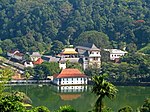Matale rebellion
This article includes a list of general references, but it lacks sufficient corresponding inline citations. (October 2014) |
| Matale rebellion (මාතලේ කැරැල්ල) | |||||||
|---|---|---|---|---|---|---|---|
| Part of the Kandyan Wars 1796-1818 | |||||||
| |||||||
| Belligerents | |||||||
|
| |||||||
| Commanders and leaders | |||||||
|
Veera Puran Appu
Gongalegoda Banda | George Byng, 7th Viscount Torrington | ||||||
| Units involved | |||||||
|
19th Regiment of Foot
Ceylon Rifle Regiment | |||||||
| Strength | |||||||
| 4000 | Unknown | ||||||
| Casualties and losses | |||||||
| Unknown | Unknown | ||||||
History of Kandy |
|---|
 |
| Kingdom of Kandy (1469–1815) |
|
| Colonial Kandy (1815–1948) |
| Kandy (1948–present) |
| See also |
|
|
The Matale rebellion, also known as the Rebellion of 1848, took place in
Background
The
However, the dispossessed peasantry were not employed on the plantations: The Kandyan villagers refused to abandon their traditional subsistence holdings and become wage-workers in the nightmarish conditions that prevailed on these new estates, despite all the pressure exerted by the colonial state. The British therefore had to draw on its
An economic depression in the United Kingdom had severely affected the local coffee and cinnamon industry. Planters and merchants clamoured for a reduction of export duties. Sir
On 1 July 1848, license fees were imposed on guns, dogs, carts, shops and labour was made compulsory on plantation roads, unless a special tax was paid. These taxes bore heavily not only on the purse but also on the traditions of the Kandyan peasant. A mass movement against the oppressive taxes was developing. The masses were without the leadership of their native King (deposed in 1815) or their chiefs (either crushed after the
Rebellion
On 26 July 1848, the leaders and the supporters entered the historic
After the proclamation of the king, he with his army left Dambulla via Matale to capture Kandy from the British. They attacked government buildings including the Matale Kachcheri and destroyed some of the tax records. Simultaneously, Dingirirala instigated attacks in Kurunegala, where eight people were killed by the British. Governor Lord Torrington immediately declared martial law on 29 July 1848 in Kandy and on 31 July in Kurunegala.
Puran Appu was taken prisoner by the British troops and was executed on 8 August. Gongalegoda Banda and his younger brother Dines escaped and went into hiding. Gongalegoda Banda lived in a cave at Elkaduwa, 13 kilometres (8.1 mi) from Matale. Torrington issued a warrant for his arrest with a reward of £150 for information on his whereabouts. On 21 September, he was arrested by Malay soldiers — although he offered resistance before his arrest - and was brought from Matale to Kandy where he was kept a prisoner.
The trial of Gongalegoda Banda commenced on 27 November at the Supreme Court sessions in Kandy. He was charged with high treason for claiming to be King of Kandy and waging war against the British. He declared that he was guilty of all the charges. The Supreme Court condemned him to be hanged on 1 January 1849. Subsequently, a proclamation was issued to amend the death sentence to
Leaders
The Matale Rebellion was led by leaders such as, Paranagama Nilame, Swarnapali Paranagama Kumarihami (daughter of Paranagama nilame ), Suriyabandara Nilame (King Of Mathale) (Son), Gongalegoda Banda, Dines, Dingi Rala and Puran Appu who were supported by the people and the village headmen of Matale. These were workers with links to the low country, with rather broader vision than the Kandyan peasants they led.
Gongalegoda Banda
Veera Puran Appu
Weerahennedige Francisco Fernando alias Veera Puran Appu is one of the most colourful personalities in Sri Lanka's history. He was born in November 1812 in the coastal town of Moratuwa. He left Moratuwa at the age of 13 and stayed in Ratnapura with his uncle, who was the first Sinhalese proctor, and moved to the Uva Province. In early 1847, he met and married Bandaramenike, the daughter of Gunnepana Arachchi in Kandy.
Legacy

The Matale Rebellion was the first transitional step towards abandoning the
See also
- Fort MacDowall
- Great Rebellion of 1817–18
- Revolutions of 1848
References
- ^ Ellman, A. O.; Ratnaweera, D. De S.; Silva, K.T.; Wickremasinghe, G. (January 1976). Land Settlement in Sri Lanka 1840-1975: A Review of the Major Writings on the Subject (PDF). Colombo, Sri Lanka: Agrarian Research and Training Institute. p. 16. Retrieved 20 December 2019.
- Tyronne Fernando, Veera Puran Appu: stood up against the might of British Empire accessed 5 December 2005.
- Dr. K. D. G. Wimalaratne, Director, National Archives, Gongale Goda Banda (1809-1849) : The leader of the 1848 rebellion accessed 5 December 2005.
- Fred Halliday, The 1971 Ceylonese Insurrection accessed 5 December 2005.
- Colvin R. de Silva, Hartal! accessed 5 December 2005.
